
The U.S. Navy’s rich tradition of christening vessels has recently come under scrutiny for inconsistencies and departures from historical naming protocols, raising questions about the influence of politics on this venerable process.

With nearly 90 ships on order and an evolving fleet composition, the debate over ship naming has intensified, reflecting a broader clash between tradition and contemporary socio-political considerations.

At the core of the discussion is a recent Congressional Research Service report that observed a perceived “breakdown in, or corruption of” the rules governing ship naming, a sentiment echoed by public opinion and analysts alike.

Navy ships have typically been named under the purview of the Secretary of the Navy, guided by congressional rules and presidential direction, but recent choices suggest a shift away from established conventions.

Historically, the Navy adhered to certain themes when naming vessels: attack submarines were named for states, destroyers honored naval personnel and lawmakers, and littoral combat ships bore the names of regionally significant cities.

Notable exceptions have emerged, however, as seen in the recent naming of Virginia-class attack submarines for previous submarines, a former Secretary of the Navy, an island, and cities.

One cannot overlook the prestige that comes with a vessel’s name, as Thomas Cutler, a naval historian at the U.S. Naval Institute, emphasizes: “It’s important if you are serving on a ship… You want to be on a ship with a name with a lot of history.” The anticipation around the naming of the fifth Ford-class carrier and the next block of Virginia-class submarines underscores the importance of these designations.

Political dynamics have long played a role in ship naming, with administrations and Congress exerting influence and suggesting names to reflect various priorities.

Recent examples include the USS District of Columbia and USS Wisconsin, the first two of the Columbia-class ballistic missile submarines, highlighting a departure from the traditional naming of submarines after states.

The choice of names for ships has invariably become a political tool, employed by both sides of the aisle to commemorate figures aligned with their ideologies or to garner support among constituents.

Ship names have also been a stage for political controversy. The Navy faced criticism for naming vessels after Confederate figures, while others pointed to oilers of the John Lewis-class being named after civil rights leaders without direct ties to the Navy.

Notably, the USNS Harvey Milk and USNS Earl Warren pay tribute to figures known for their social justice advocacy rather than their naval service.

Yet, the Navy’s flexibility in naming ships can be seen as a reflection of the evolving American ethos. The USS Gabrielle Giffords, named for a living person contrary to traditional protocols, sparked debate and calls for investigation, but ultimately demonstrated the Navy’s ability to adapt its traditions to contemporary cultural currents.

In reconciling tradition with progress, the Navy continues to balance the demands of congressional influence, public sentiment, and the need for symbolic representation on the high seas.

As the report implies, the tradition of exceptions in ship naming is likely to persist as a testament to the complex interplay between military heritage and the evolving American narrative. With each new christening, the Navy not only launches a vessel but also anchors a piece of history and identity within its fleet.
Relevant articles:
– Report to Congress on Navy Ship Names, USNI News
– Traditions vs. politics: The long and undisciplined history of Navy ship-naming, Stars and Stripes
